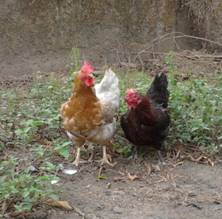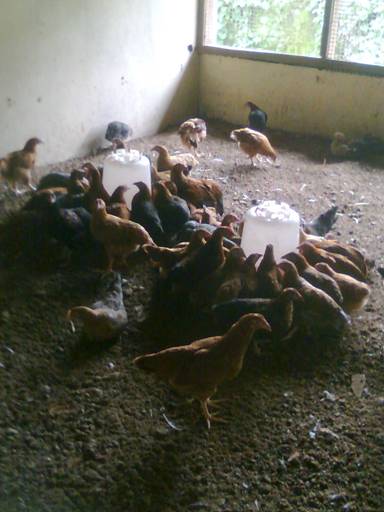
animal: vanaraja
Scientific name :
Common / Local Name :
The product from native fowls is widely preferred specially because of their pigmentation, leanness, taste, flavour and suitability for special dishes. Only drawback of native fowl is lower production and slow growth. The growth and production can be improved by introduction of improved germplasms with better management. In this situation backyard poultry breed with an egg production capacity of 150-200 and 1.2-1.4 Kg body weight at 10-12 weeks of age is viable in rural village condition. This production ensures the availability of poultry meat and eggs for the rural masses at cheaper rate which not only supplement the family nutrition and health but also provides supplementary income. The following technology adoption will meet the demand of farmers in rural areas to augment the income generation in addition to more employment generation.
Brooding is the care and management of new born chicks for successful rearing without hen. During initial stage of life, chicks cannot regulate their body temperature. They need artificial heat to maintain their body temperature. The young chicks need brooding up to 4 weeks of age. The brooding arrangement can be made either on floor or in cages as per the available facility. There should be adequate ventilation in brooder house to maintain balance of oxygen and carbon dioxide. Brooder house should be thoroughly cleaned and disinfected with a disinfectant solution (Phenol/Cresol) before arrival of chicks. All equipments like feeders, drinkers, hovers/brooding cages should be thoroughly cleaned before brooding is started. For floor brooding 2-3 inch thick layer of saw dust/rice husk/locally available litter material should be spread on the floor uniformly. Initially for 2-3 days news paper should be spread over the litter material to prevent chicks from eating litter till they learn eating feed because litter material may choke their throat causing death due to suffocation. Brooders should be warmed up 24 hours prior to the arrival of chicks. Optimum temperature of brooder house promotes good growth rate and reduces mortality in chicks. The starting temperature during brooding should be 95 0F in first week and should reduce 5 0F per week in successive weeks till 70 0F. Monitoring chicks behavior in brooder is important to note whether they are comfortable or not. If temperature is higher than the requirement, chicks will stay away from the heat source and if it is lower than the requirement they will come closer to the heat source. Chicks guard may be prepared from tin, hard card board or any other such locally available materials. Healthy and physically good chicks should be selected for brooding.







Housing is required for night shelter and protection from rain and predators. This can be done by use of low cost material i.e. wire mesh or unused fishnet, bamboos and tarpaulin sheet. With the help of bamboo and wire mesh outside covering can be done and roofing can be done with tarpoline sheet/old asbestos sheet. Coconut leaves can substitute tarpoline/old asbestos sheet for roofing to reduce the cost of housing wherever available in plenty from own source. About 1.5-2.0 square feet floor space is required per bird. If good quality wire mesh is used for the preparation of night shelter with cement flooring and asbestos roofing, it will be durable.
The male vanaraja kept on low density diet attain optimum bodyweight for table purpose at the age of 10-12 weeks . Female birds lay up to 120 eggs per annum under backyard condition with minimum input cost. In backyard condition protein requirement is met through scavenging on insects but chances of protein deficiency are there. Therefore, feeding of birds with different cereals like broken rice, ragi (Nachni) etc available in rural areas is always beneficial to sustain optimum production.
The diet of vanaraja can be formulated using locally available feed ingredients like bajra, ragi, jowar, broken rice or rice kani and cashew apple waste as energy sources, sunflower cake, and groundnut cake as protein sources. The nature of the supplemental feed depends upon the purpose for which the birds are reared i.e. either for egg or for meat purpose. If it is for meat purpose then feeding of commercial broiler starter is suggested up to marketing age i.e. 10-12 weeks. If the purpose is for egg production grower mash can be fed up to 4 weeks followed by either complete feed or cereal s like bajra, jowar, broken rice with equal parts of rice polish or rice bran, feed with inclusion of agro-wastes i.e. brewers?dried grain and cashew apple waste replacing maize up to 20 % level can be fed depending upon the forage conditions available in the backyard. The feeding practices should be regulated to monitor the desired body weight of vanaraja during laying period because high body weight will reduce the egg production. Sometimes the broken or shellless eggs can be minimized by supplementing the calcium sources (limestone powder, shellgrit or stone grit) etc. @ 3-4 g/bird/day. Care should be taken to restrict the weight of pullets (female) between 2.2 to 2.5 kg at 6.0 to 6.5 months of age i.e. age at sexual maturity.
 Nursery Rearing
Nursery Rearing
 Male and Female
Male and Female
Suggested Practical Rations for Vanaraja chicks:
Ingredients Diet using CAW Diet using rice kani Diet using brewers’ �?
dried grain
Ground maize 40.00 30.00 43.00
Cashew apple waste 10.00 - -
Soybean meal 20.00 24.00 21.00
Fish meal 10.00 10.00 -
Broken rice - 20.00 -
Deoiled rice bran 19.00 15.00 13.00
Brewers?dried grain - - 20.00
Dicalcium phosphate 1.30 1.20 1.17
Lime stone 1.12 1.34 1.21
Common salt 0.40 0.50 0.50
Vitamin and
Mineral mixture 0.30 0.30 0.30
Average feed consumptions per bird per day
1st week -10 gm
2nd week -20gm
3rd week -30gm
4th week -50 gm
5th week -70 gm
6th week - 80 gm
7th and 8th week-90 gm
During initial 4-6 weeks, the vanaraja chicks need brooding to maintain required body temperature. During this period they must be vaccinated against marek’s disease and ranikhet disease (Table 2). After 6 weeks they can be allowed to backyard for scavenging the free range area. During the initial acclimatization care should be taken to habituate them to reach the nest in the evening for night shelter. Night shelter should have proper ventilation, required light and protection from predators. Since, the chicks move in free range, there is possibility of parasitic infection. Therefore, periodic deworming at 2-3 month interval is required. For this purpose albendazole oral suspension (Albomar) can be given @ 3-5 ml/10 birds. Under backyard condition adult vanaraja birds should be vaccinated against ranikhet disease at six monthly intervals. Since, there is a chance of transmission of diseases from native birds to vanaraja, vaccination of vanaraja along with native birds is suggested. White diarrhoea can be treated by administration of Tetracycline hydrochloride powder in drinking water @ 1g/litre for 3-5 days. For better egg output and survivability, the weight of vanaraja should range between 2-2.5 kg. Excess body weight (> 3 kg) considerably reduces the egg production. The weight of vanaraja can be regulated to some extent through controlled feeding of cereals. The following vaccination schedule can be adopted for protection from prevalent diseases and keep the birds healthy for better production.
Vaccination Schedule
Age(days) Name of the vaccine Dosage Route of administration
1 Marek’s Disease 0.20 ml Subcutaneous
7 Ranikhet Disease (Lasota) one drop Eye drop
18 Ranikhet disease (Lasota) one drop Eye drop
28 Ranikhet Disease (R2B) 0.50 ml Subcutaneous or IM
42 Fowl Pox 0.20 ml Intramuscular
Input availability |
Address/Contact details |
| Germplasm | Director, ICAR-CCARI, Old Goa-403 402, Goa Phone: (0832) 0832-2993097, E-mail: director.ccari@icar.gov.in |
|